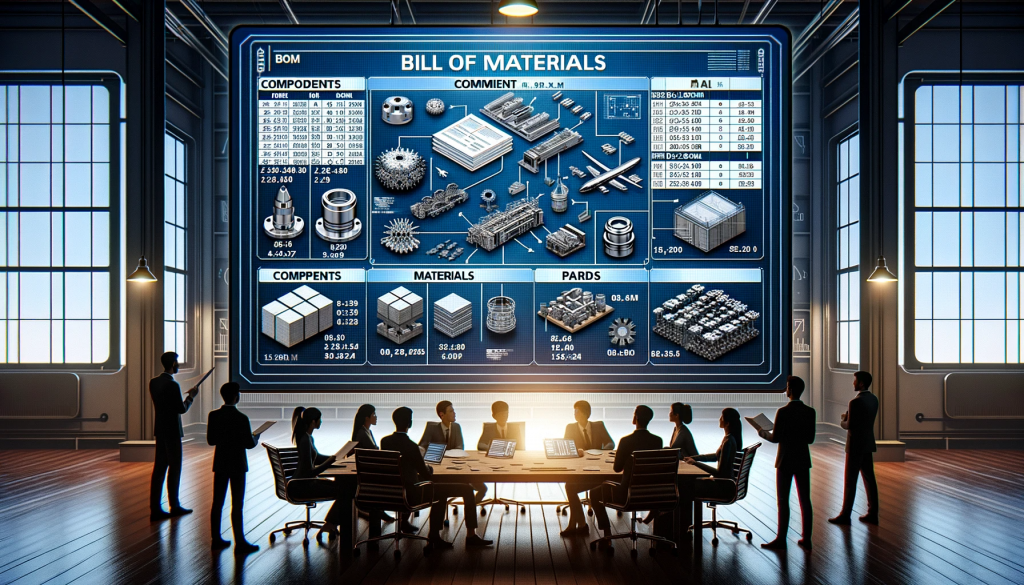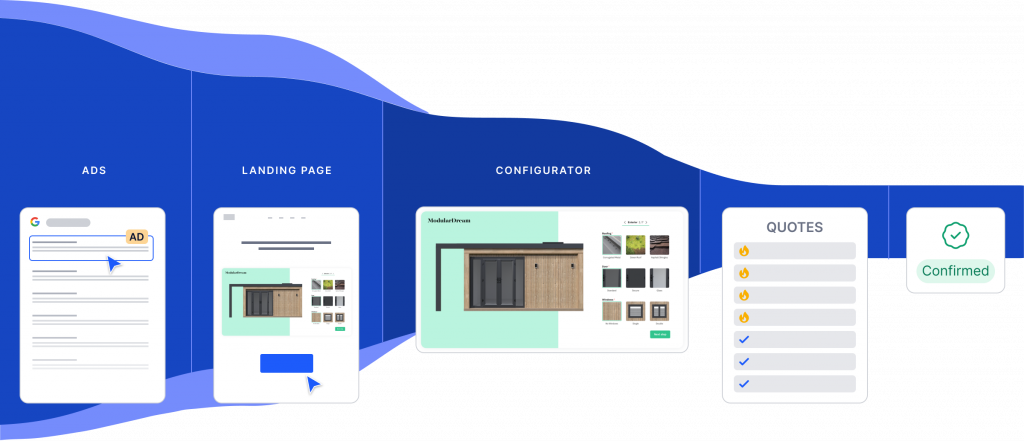
BOM is the secret behind every manufacturing company’s success. It enables companies to efficiently source thousands of parts and components for the assembly of the finished product while planning, process planning, and managing inventory effectively. As a manufacturer, a bill of materials is one of the most critical tools in your arsenal to optimize costs and streamline operations. In this article, you’ll get a quick primer on what exactly a bill of materials is, the different types you can create, and how leading companies utilize bill of materials to enhance productivity and profits. You’ll also discover some practical tips to help you overcome common challenges in managing bills of materials for your business.
What Is a Bill of Materials (BOM)?
A bill of materials or BOM is a comprehensive material list of all the raw materials, assemblies, subassemblies, components, parts, and quantities needed to produce one unit of a product, providing a detailed product structure. It provides a complete, structured view of the product and helps in inventory management, especially important in the construction and manufacturing processes, through the detailed component list.
For manufacturers, the bill of materials (BOM), along with thorough documentation, serves as the foundation for production planning, costing, purchasing, scheduling, and manufacturing supply chain management. It helps streamline operations by detailing exactly what components, materials, and manufacturing details, and in what amounts are required to make a product. This allows companies to accurately calculate costs, ensure adequate inventory, and effectively plan production.
There are several types of BOMs used for different purposes, including single-level BOMs:
- Engineering BOM: Created by engineers during product design. It details all the parts needed for a product and serves as a comprehensive bill of materials.
- Manufacturing BOM: Used by production planners to specify materials and components required for production in a bill of materials. It may differ from the engineering BOM.
- Costed BOM: Adds costing details like part prices, labor, and overhead costs to the bill of materials. It is used to determine the total cost of a finished product.
- Sales BOM: Simplified version of the bill of materials used by sales teams that only includes parts and materials visible to the customer and essential for the product.
Bill of materials is used across industries like aerospace, automotive, electronics, manufacturing, machinery, and medical devices to manage both production and inventory. For example, an automaker would have a bill of materials and a material list for each vehicle model listing everything from large assembly assemblies down to the smallest nuts and bolts. An electronics manufacturer would have a bill of materials for each product specifying all electronic components, wires, casings, packaging, and manufacturing details, reflecting the entire product structure.
Managing BOMs does present challenges like keeping them up to date as product lines change, ensuring accuracy of components, and facilitating collaboration between departments and inventory management systems, all of which require meticulous process planning and thorough documentation. Following best practices like standardizing bill of materials formats, automating where possible, and maintaining clear communication can help overcome these challenges and maximize the benefits of bill of materials.
Types of BOMs and Their Uses
Manufacturers utilize various types of bill of materials for different purposes, especially during the construction phase. The most common in manufacturing, including single-level BOMs, are:
Engineering bill of materials
Also known as E-BOM, this single-level bill of materials contains all the information needed to design and engineer a product including drawings, 3D models, and specifications of parts and subassemblies. They are living documents that evolve as the product design changes, and proper documentation is essential to maintain their accuracy and relevance. They provide an overview of the product structure, the inventory, and all the components required for its construction, often compiled into a detailed material list or component list. Companies use them to configure products for customers based on their unique needs and requirements.
Manufacturing bill of materials
Known as M-BOM, this transforms the E-BOM into a buildable design by specifying the exact parts, materials, components, and assemblies required for manufacturing and assembly, including detailed manufacturing details, effectively serving as a comprehensive bill of materials. They break down the product into manufacturable chunks by optimizing the E-BOM for efficiency and cost-effectiveness. It contains crucial data such as part numbers, quantities, inventory levels, and the sequence of operations needed to construct the finished product. They are used on the shop floor to drive automated equipment and ensure the right parts are used at the right time.
Costed bill of materials
The costed BOM, or C-BOM, builds on the M-BOM by adding pricing details for raw materials, components, and assemblies. It provides a complete cost breakdown of the product which helps with tasks like budgeting, estimating, and controlling inventory costs, all contained within a comprehensive bill of materials. However, they require frequent updates as material and component prices change. Maintaining accurate costed bills of materials can be challenging, but when done right, they give companies valuable insights into profit margins and cost optimization opportunities.
For selling products and growing the company, the most important product-related documents are the sales bill of materials and configurable bill of materials. These two are mostly used in the sales process to configure products and in order processing to configure the order for production.
The key to effective bill of materials management is process planning the use of the right types of BOMs for their intended purposes, keeping them up-to-date, and ensuring synchronization across departments. With the proper bill of materials strategy and tools in place, manufacturing companies can boost efficiency, reduce errors, and gain a competitive edge.
What are the examples of bill of materials?
Understanding real-world examples of bills of materials can provide valuable insights into their practical application and underscore their importance across various industries. Here are some illustrative examples:
Automotive Industry
In the automotive sector, a bill of materials for a vehicle model might include:
- Assemblies: Engine, transmission, body, chassis, interior, and electrical systems.
- Subassemblies: For the engine assembly, components such as the crankshaft, pistons, valves, and oil pumps are listed.
- Components: Smaller parts within the subassemblies like bolts, screws, gaskets, and connectors.
- Materials: Metals, plastics, lubricants, and fluids required for both the manufacturing process and vehicle operation.
- Quantities and Specifications: Precise measurements, part numbers, and material grades to ensure consistency and quality.
This structured approach ensures that every aspect of the vehicle’s construction is accounted for, from the largest assemblies to the smallest fasteners, contributing to efficient inventory management and production scheduling.
Electronics Manufacturing
An electronics manufacturer producing a smartphone would have a bill of materials detailing:
- Raw Materials: Metals for the casing, silicon for chips, and glass for the display.
- Components: Circuit boards, processors, memory units, cameras, batteries, and screen components.
- Subassemblies: Display assembly, camera module, touch interface, and connectivity chips.
- Packaging Materials: Boxes, protective film, instruction manuals, and accessories like chargers and earphones.
- Manufacturing Details: Specifications for soldering, mounting components, testing sequences, and assembly instructions to ensure proper construction and functionality.
This comprehensive bill of materials facilitates precise cost estimation, streamlined procurement, and meticulous quality control, ensuring the final product meets high standards of performance and reliability.
Aerospace Industry
In aerospace manufacturing, a bill of materials for an aircraft might encompass:
- Major Assemblies: Wings, fuselage, tail, landing gear, and propulsion systems.
- Subassemblies: Within the wing assembly, items such as control surfaces, wingtip devices, fuel tanks, and structural ribs are included.
- Components: Fasteners, wiring harnesses, hydraulic lines, and avionics.
- Materials: High-grade aluminum, composite materials, adhesives, and sealants used in the construction process.
- Regulatory Compliance Details: Certifications, specification documents, and quality control checkpoints to meet stringent aerospace standards.
This detailed BOM ensures synchronization across the engineering, manufacturing, and supply chain departments, enabling the production of high-precision, safety-critical components to exacting standards.
Medical Devices
For a medical device manufacturer, a bill of materials for a complex device like an MRI machine would include:
- Main Assemblies: Magnet system, gradient coil system, RF coil system, and patient handling system.
- Subassemblies: Specific subsystems within the main assemblies, such as the cooling system for the magnet and the electronics for signal processing.
- Components: Screws, cables, sensors, and connectors.
- Materials: Specific grades of metals, polymers, and shielding materials essential for maintaining device integrity and safety.
- Compliance and Documentation: Regulatory approvals, testing protocols, and user manuals ensuring the device meets healthcare standards and operates correctly.
By having a detailed and accurate bill of materials, medical device manufacturers can ensure that each unit is manufactured to rigorous specifications, ensuring patient safety and device reliability.
By examining these examples, one can appreciate the diversity and specificity required in the creation and management of bills of materials across different manufacturing industries. This critical document not only defines the components and materials needed but also drives the efficiency, accuracy, and success of the production process.
How to Create a Bill of Materials (BOM)?
Creating a bill of materials (BOM) involves a meticulous process that ensures all necessary components, assemblies, and materials are accounted for in the product manufacturing cycle. Here’s a step-by-step guide:
Step 1: Define the Product Structure
Begin by outlining the product’s structure, including the main assemblies and subassemblies. Understanding the hierarchy of the product will allow for a clearer and more organized BOM. This involves listing all larger components first, breaking them down into smaller parts and subcomponents.
Step 2: List All Components and Materials
Detail every part, material, and component required to complete the product. Each entry should include precise descriptions, part numbers, quantities, and specifications. This comprehensive list could cover everything from raw materials to finished subassemblies, ensuring no element is overlooked.
Step 3: Assign Part Numbers
Assigning unique part numbers to each component is essential for tracking, inventory management, and maintaining consistency across departments. Part numbers should be logical and standardized to prevent any confusion.
Step 4: Document Specifications and Details
Include all necessary specifications and details for each component. This may involve dimensions, material grades, manufacturing processes, and compliance information. Thorough documentation aids in quality control and ensures all parts meet the required standards.
Step 5: Incorporate Cost Information
For costed BOMs, include pricing details for every part and material. This should encompass the cost of raw materials, labor, overheads, and any other expenses related to the production of the component. Accurate cost details empower better budgeting and pricing strategies.
Step 6: Ensure Regulatory Compliance
For industries with stringent regulatory requirements, it’s crucial to incorporate all necessary compliance and certification details. Ensure that every component and material listed meets industry standards and regulatory guidelines to avoid any legal or quality issues.
Step 7: Review and Finalize the BOM
Before finalizing, review the BOM meticulously to ensure all components, materials, and respective details are accurate and complete. Engage key stakeholders from different departments—engineering, manufacturing, procurement, and finance—to vet the BOM, addressing any discrepancies or omissions.
Step 8: Regular Updates and Maintenance
A BOM is a living document that should be regularly updated to reflect any changes in the product design or manufacturing process. Maintaining an accurate and up-to-date BOM ensures continuous efficiency and adaptability in manufacturing operations.
Step 9: Implement BOM Management Tools
Utilize specialized software and BOM management tools to streamline the creation, updating, and sharing of BOMs across the organization. These tools facilitate collaboration, enhance accuracy, and provide a centralized repository for all BOM-related data, boosting overall operational efficiency.
Step 10: Training and Communication
Ensure that all relevant personnel are adequately trained in BOM management and understand its importance. Clear communication across departments helps in maintaining the integrity and accuracy of the BOM, fostering a culture of diligence and precision.
By following these steps, manufacturers can create detailed, accurate, and effective bills of materials that drive successful product development, efficient production, and strategic cost management. The meticulous creation and maintenance of BOMs empower companies to tackle challenges head-on, innovate continuously, and achieve substantial competitive advantages.
